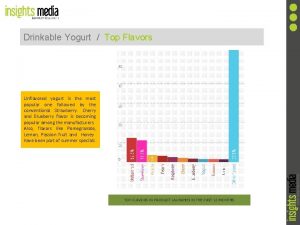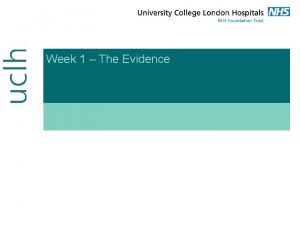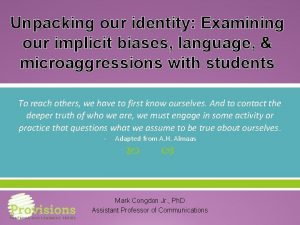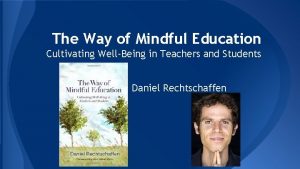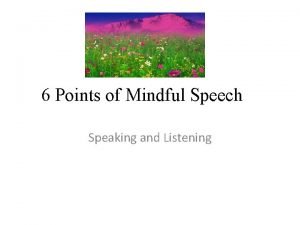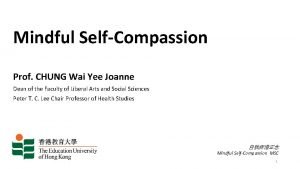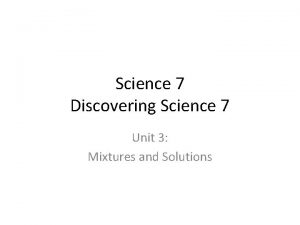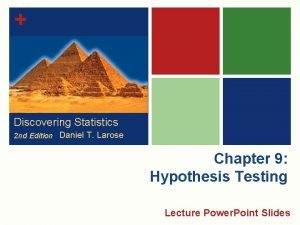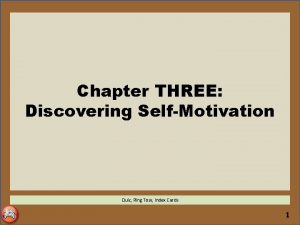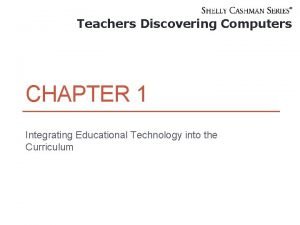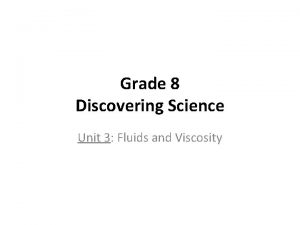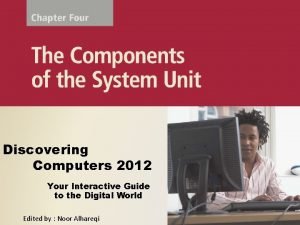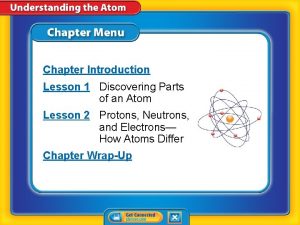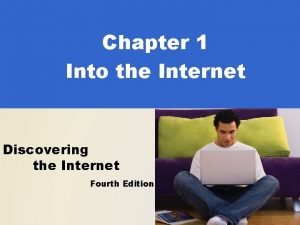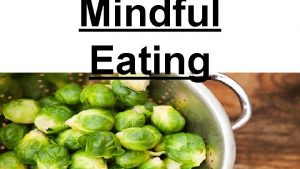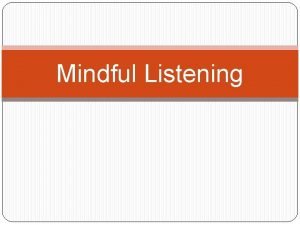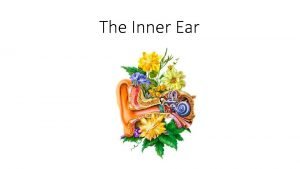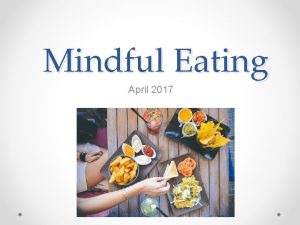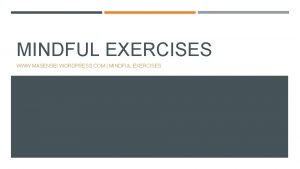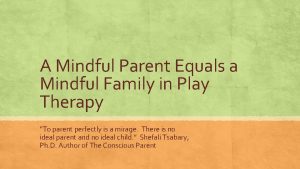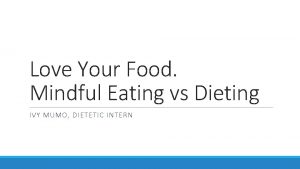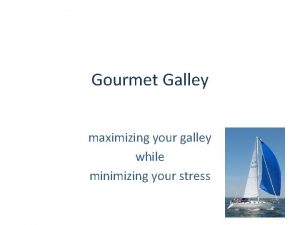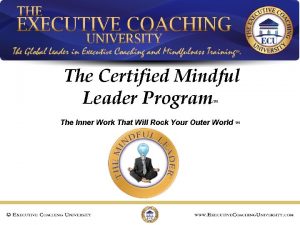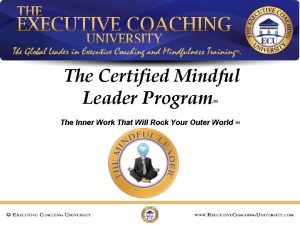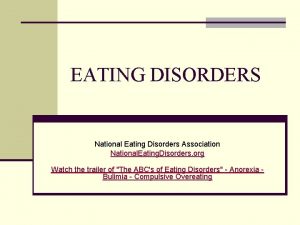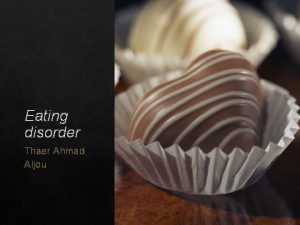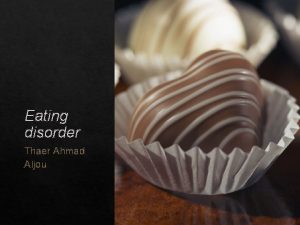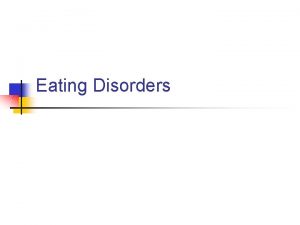Mindful Eating Wise Eating Discovering Your Inner Gourmet












































- Slides: 44

Mindful Eating, Wise Eating: Discovering Your Inner Gourmet University of Chester – 7 -16 -14 Jean L. Kristeller, Ph. D. Dept. Of Psychology Indiana State University JKristeller@indstate. edu The Center for Mindful Eating www. tcme. org

Overview Making sense of mindless eating, eating problems and obesity l Mindfulness as a way to cultivate inner wisdom and outer wisdom… l l Mindful eating: the core experience…. l Research to date on mindful eating….

“Fast Food Nation” In the U. K, about 61% of adults are overweight or obese (23% of adults). l l. Prevalence of obesity in children has more than tripled in the last 25 years. l. Binge eating is the most prevalent eating disorder, increasing with degree of obesity. Marketing of fast food/snacks takes advantage of our natural tendency to prefer high fat and high sweet foods. l

Eating Problems ? Obesity Eating Problems BUT Exactly what pattern of underlying problems can’t be known from level of obesity…

Mindless Eating …… l Failing to tune into physical hunger signals l Oversensitivity to other types of eating triggers l Failing to tune into taste satiety cues (“sensory specific satiety”) l Failing to tune into moderate fullness cues l Choosing foods without considering nutritional value (calories, fat content, health benefits) l And failing to enjoy (savor!) food when it is eaten!

Automatic Reactivity and Eating Cravings Emotions Temptation Socializing Binging Overeating X Fasting Grazing

But Many Different Patterns of Mindless Eating … l Heavy since childhood: Has always eaten ‘junk food’, low levels of activity, being heavy is part of self-image. l Eating to handle stress: Finding eating particularly comforting in the face of stress or depression. May or may not have serious weight problem. May also eat out of control for other reasons. l Grazing: Eating frequently throughout the day, whenever food is available; eating when bored. l “Large” eater: Gradually gained weight (~10 lbs/year); may diet but often eats larger meals & fast food; friends, family may also be overweight. Food intake has crept up (e. g. , only 100 extra calories/day), while exercise has decreased. l Binge eater: Has ≥ 2 large binges/week, eating out of control, mostly on high fat, high sweet foods. Alternates with normal patterns or dieting. Fluctuates with stress, depression, access to food. More likely in heavier individuals (> 30%? ).

3000 KCalories: Overeating vs. Bingeing Overeating Pattern Time 7 am KCal 2 eggs, bacon 2 slices toast OJ 10 am Doughnut Noon Whopper Medium Fries 6 pm 10 pm Bingeing Pattern 350 1030 6 oz. Steak Baked potato 2 vegies, roll Apple pie 1120 1 oz. Doritos 1 beer 350 TOTAL 3000 Kcal Cereal/milk OJ 260 Salad w/ dressing Roll and butter Diet Coke 300 3 oz steak Baked potato 2 vegies 500 2 pieces Apple pie 5 oz. Doritos 1 pint ice cream 1940 TOTAL 3000

Usual Solution: Dieting!! l Pros – Provide a structured alternative to out-of-control eating – Can educate about healthier choices – Redirects usual mindless eating l Cons – Overly restrictive: good food/bad food mentality. – Sense of deprivation. – Diets rarely teach moderate or flexible eating appropriate to LONG- TERM weight goals – Diets don’t teach mindful eating – and create more mindlessness!!!



“ Mindfulness … moment to moment nonjudgmental awareness cultivated by paying attention. ” Jon Kabat-Zinn

MINDFULNESS: a cognitive state, marked by attentional stability, that disengages habitual reactions and allows for inner wisdom to emerge.

Meditation as Awareness l l l Focus on an object, often repetitive, and often the breath to train attention and disengage ruminative thinking (quieting the ‘monkey mind’) A physically awake state Quiet detached noting of other thoughts, experiences, sounds, feelings, etc. , as they arise A gentle return to the original point of focus whenever attention has wandered Use of mindfulness to increase awareness of, and a shift in response in, other aspects of functioning, such as pain, anxiety, relation to others, eating, etc.

“Mindlessness” ~~ Habitual Reactivity The brain/mind is designed to be constantly scanning -both externally and internally -- for meaningful information. l Meaning: attachment or aversive, positive or negative associations, craving or avoidance. l l l Much of this happens without awareness. Responses are then triggered as rapidly as possible. Responses become ‘reactivity’ with a sense of loss of control, loss of choice, and intense affective valence. l

How is it that these relatively simple cognitive processes have such a wide range of clinical effects? ? For example: l. Improvement in psycho-biological regulation, including blood pressure, chronic pain, immune disorders. Cultivation of emotional well-being, decrease in anxiety, improvement in depression, anger management. l Improvement in behavioral regulation: alcohol and drug addiction, disordered eating, smoking. l l. Cultivation of compassion, loving-kindness, and spiritual well-being and transformation.

Mindfulness Meditation: Self-Regulation and a Multi-Domain Model The first stage of mindfulness meditation heightens awareness of the reactive process. l The second stage disengages the automatic reactivity specific to the targeted experience. l The third stage allows emergence of more integrative response potentials in whichever domain of functioning is being engaged. l

Meditation: Mechanisms and Misunderstandings l Meditation is NOT a trance state. l Meditation is NOT primarily a relaxation tool. l Meditation is FUNDAMENTALLY a cognitiveattentional process that promotes self-regulation. l It has potential effects across MULTIPLE DOMAINS of psychological functioning: cognitive, physiological, emotional, behavioral, relation to self/others, and spiritual.

Reconnecting Wisdom ‘Serial processing’ vs. ‘parallel distributed processing’ (Mc. Clelland, Rumelhart & Hinton, 1986) l Under threat or stress, serial processing predominates. l The alternative, parallel distributed processing, allows for more complex, integrated responses. l Such responses inherently engage fuller selfregulation and are experienced as less ‘automatic’ and more under self-control l


Mindful Eating = Quality over Quantity!!

Mindfulness-Based Eating Awareness Training “INNER WISDOM” l Mindfulness meditation l Eating experience meditations: – Awareness of binge triggers – Awareness of hunger – Awareness of satiety (taste-specific, fullness) l Food-related meditations: raisin, chocolate, cheese/crackers, pot luck meal/buffet. Mini-meditations with daily meals and snacks. l Forgiveness and wisdom meditations l Homework: meditation practice, mindful eating. l

Mindfulness-Based Eating Awareness Training “OUTER WISDOM” Food Pyramid/My Plate 500 Calorie Challenge l Calorie awareness with self-acceptance l Calorie needs (~~100 cals/hour) l l Exercise Planning l Pedometer Use l Adapting to personal preferences and patterns l


NIH Trial (R 21): Mindfulness-Based Eating Awareness Training (MB-EAT) Co-PI: Ruth Q. Wolever, Ph. D. , Duke University l NCCAM-funded randomized clinical trial with 3 groups: MB -EAT; Psycho-educational; Waiting List. l Two-site design (ISU and Duke University); Sample size: N = 150 evaluated on all baseline measures and randomized; 13% men; 14% African-American. l Average = 46. 55 (range: 20 -74); Avg. Wt. = 240 lbs. ; Avg. BMI = 39. 9 week manualized intervention including body awareness work l 1 and 4 month followups l Extensive process measures, EDE assessment, biological markers of self-regulation (lipid and metabolic profiles)

Changes in Number of Binge Days in Previous Month p<. 01 (N =85) Preliminary results - do not quote without permission.

Treatment Effects on the Stunkard & Messick Eating Inventory: Disinhibition Scale p<. 001 Preliminary results - Do not quote without permission (N =85)

Treatment Effects on Lowe’s Power of Food Scale p<. 05 (N =90)

Relationship Between Practice and Improvement in Relation to Eating (n = 31 -34) Change in: Type of Practice BES Less Disinhibition Less Hunger Weight General Mindfulness -. 28 -. 17 -. 26 -. 20 Eating Meditation -. 26 -. 34+ -. 20 -. 28 Mini-Meditations -. 31** -. 28 -. 19 -. 33+ Combined Index -. 32** -. 38* -. 34+ -. 41*

Relationship Between Meditation Practice and Improvement in Eating l All types of meditation practice contributed to improvements in eating l Greatest effect from ‘mini-meditations’, particularly in regard to decreasing a sense of eating out of control l Weight loss was predicted by a combination of practice experience

Change in # of Days Binging and Change in Hb. A 1 Cs and Fasting Levels (n = 43 -50) Change in: HBA 1 C Fasting Glucose Fasting Insulin Sensitivity Change in # of Binge Days . 33* . 28** . 36** . 35** Change in Weight (M=. 07 lbs. ; range: 15 to +45) . 05 . 10 . 22 . 20 . 31* . 27* . 31* . 34* Change in # of Binge Days, Controlling for Wt.

Relationship Between Meditation Practice and Improvement in Metabolic Regulation l Individuals in the MB-EAT program showed the greatest improvement at 4 month followup in post-prandial glucose l Improvement in Hb. A 1 Cs and fasting glucose, insulin, and insulin sensitivity was predicted by improvement in binging, NOT by weight loss.

NIH Trial (R 01): MB-EAT – WL (with Weight Loss) l NCCAM-funded randomized clinical trial with 2 groups: MBEAT-WL; Waiting List. l Sample size: N = 120 evaluated on all baseline measures and randomized. l 12 week manualized intervention adding nutrition, diet information and 500 calorie challenge + cals/hour l 1, 2 and 6 month followups

MB-EAT: Treatment Effects on Binge Eating Scale (Wait List vs. Treatment by Binge Status) P=. 05 (N = 80)

MB-EAT: Treatment Effects on TFEQ: Disinhibition p<. 05; Bed vs. non-BED: p<. 01 (N = 80)

MB-EAT: Treatment Effects on TFEQ: Cognitive Restraint p<. 001 (N = 80)

MB-EAT: Treatment Effects on Weight Loss p<. 001 (N = 80)

After 4 Months …. at Peace l Jean: So I’m curious. How are you using the mindfulness? What are you noticing when you are using it? l Jane: I use it with everything. I mean, when I get upset at work I just go in the bathroom and do a mini meditation. Sometimes I count to 10 or I just breathe and I don’t binge anymore, at all. I mean, I don’t really diet but I don’t binge at all.

Getting off the Yo-yo dieting… l Jean: So you’re finding you can put some limits on things that you weren’t able to do before without over-reacting …? l Lucy: Yes … I’ve always been sort of looking for whatever would help me to be able to do that without doing the “yoyo” thing. I didn’t want to do that and I didn’t want to try something I was going to fail at. And I feel real comfortable – that this is going to be o. k. It’s going to be how it is from now on. I’m at peace at this point.

Balanced Eating, not Anger Eating…. l Bob: I haven’t come to the “Zen Master” level as has Jane. … (laughs). Actually I don’t make it a point to just go out and binge as I did before. You know the willful rebellion – it seems that’s started to be released some. …. It’s outrageous – my self-will is so strong. It doesn’t seem as if the willful rebellion is as bad as well, o. k. , you know I [used to] map it out that I’m going to go and really binge. l Juli: Like the Chinese restaurant buffet? l Bob: Yeah.

What Can I Do for Myself ? ? l l l l Begin to notice when eating mindlessly is causing problems – either too much food or poor choices. Consider food choices as opportunities, not constraints! Before every meal and snack, check on your ‘inner hunger’ – is it physical or psychological, how hungry are you? While eating, check in on your ‘inner gourmet’…are you still really enjoying each bite? If not, STOP! Check in on fullness…how full do you WANT to be? What’s comfortable? Be patient with yourself…eating habits took many years to develop – they will take some time to change. And be kind and generous to yourself…. you are much more than your weight, your body, or your food choices.

Resources l On Mindless Eating/Eating Regulation: – Brian Wansink. Mindless Eating. – Capaldi. Why We Eat What We Eat. The Psychology of Eating. l On Mindful Eating: – David Altman. Art of the Inner Meal – Jan Bays. Mindful Eating. – Kristeller. Know Your Hunger. Spirituality and Health. 2005. Pp. 29 - 35. – The Center for Mindful Eating (TCME). l www. tcme. org On Meditation: – Jon Kabat-Zinn. Full Catastrophe Living. – Stephen Bodian. The Dummies Guide to Meditation. – Kristeller. Meditation. In Oxford Encyclopedia of Stress.

Acknowledgments Indiana State University Brendan Hallett, Psy. D. Virgil Sheets, Ph. D. Kevin Bolinskey, Ph. D. Michele Boyer, Ph. D. , June Sprock, Ph. D. , and Randy Stevens, M. D. Courtney Stahl, M. S. , Kobita Rihkye, M. S. , Michelle Drerup, M. S. , Tamara Johnson, Ed. M. Juli Buchanan, M. A. , Sandra Hooper, Tim Neary, Michael Ann Glotfelter, R. N. Anita Farrell, M. A. Terre Haute Medical Labs Duke University Sasha Loring, M. S. W. Jennifer Davis, M. S. Jessica Psujeck, M. S. Jennifer Best, Ph. D. Richard Liebowitz, M. D.

This work was supported by grants from National Center for Complementary and Alternative Medicine National Institutes of Health U. S. Department of Health and Human Services www. nccam. nih. gov Funded by Grants # 1 R-21 AT 00416 -01 and U 01 AT 002550 to Jean Kristeller from the National Center for Complementary and Alternative Medicine
 Inner defender and inner guide examples
Inner defender and inner guide examples He who walks with the wise grows wise
He who walks with the wise grows wise Elit gourmet collection assorted chocolate selection
Elit gourmet collection assorted chocolate selection Chobani flip flavors ranked
Chobani flip flavors ranked Picasso early years
Picasso early years Inner critic and inner defender
Inner critic and inner defender Mindful nation uk
Mindful nation uk Space2 model of mindful inclusion
Space2 model of mindful inclusion Mindful smelling activity
Mindful smelling activity The way of mindful education
The way of mindful education Mindful coach radnor
Mindful coach radnor Radnor naviance
Radnor naviance What is mindful speech
What is mindful speech Mindful moment
Mindful moment Mindful employer
Mindful employer Mindful listening key skills
Mindful listening key skills Mindful smelling
Mindful smelling Job description and job specification in hrm
Job description and job specification in hrm Monk by the sea analysis
Monk by the sea analysis Discovering computers 2018 ppt
Discovering computers 2018 ppt Discovering computers 2016
Discovering computers 2016 Discovering computers 2018 chapter 1
Discovering computers 2018 chapter 1 What is self motivation
What is self motivation Discovering science 7
Discovering science 7 P value
P value Discovering economic systems comparative worksheet answers
Discovering economic systems comparative worksheet answers Discovering computers 2011
Discovering computers 2011 Discovering self motivation
Discovering self motivation Discovering computers 2018 chapter 1
Discovering computers 2018 chapter 1 Discovering science 7
Discovering science 7 Muhammad computer technology
Muhammad computer technology Discovering engineering
Discovering engineering Defining and debating america's founding ideals
Defining and debating america's founding ideals Teachers discovering computers
Teachers discovering computers Discovering science 7
Discovering science 7 Example of fluid
Example of fluid Amenhotop
Amenhotop Discovering personal genius
Discovering personal genius Tactile output
Tactile output The system generates regular electronic pulses
The system generates regular electronic pulses Ethics discovering right and wrong
Ethics discovering right and wrong Chapter 7 lesson 1 discovering parts of an atom answer key
Chapter 7 lesson 1 discovering parts of an atom answer key Discovering the internet
Discovering the internet Discovering cells
Discovering cells Discovering our past ancient civilizations
Discovering our past ancient civilizations



